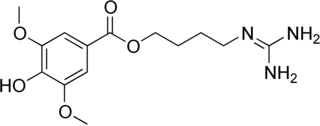Isobutane, also known as i-butane, 2-methylpropane or methylpropane, is a chemical compound with molecular formula HC(CH3)3. It is an isomer of butane. Isobutane is a colourless, odourless gas. It is the simplest alkane with a tertiary carbon. Isobutane is used as a precursor molecule in the petrochemical industry, for example in the synthesis of isooctane.
In chemical nomenclature, the IUPAC nomenclature of organic chemistry is a method of naming organic chemical compounds as recommended by the International Union of Pure and Applied Chemistry (IUPAC). It is published in the Nomenclature of Organic Chemistry. Ideally, every possible organic compound should have a name from which an unambiguous structural formula can be created. There is also an IUPAC nomenclature of inorganic chemistry.

Bumetanide, sold under the trade name Bumex among others, is a medication used to treat swelling and high blood pressure. This includes swelling as a result of heart failure, liver failure, or kidney problems. It may work for swelling when other medications have not. For high blood pressure it is not a preferred treatment. It is taken by mouth, or by injection into a vein or muscle. Effects generally begin within an hour and lasts for about six hours.

tert-Butyl alcohol (TBA), also called tert-butanol or t-butanol, is the simplest tertiary alcohol, with a formula of (CH3)3COH (sometimes represented as t-BuOH). It is one of the four isomers of butanol. tert-Butyl alcohol is a colorless solid, which melts near room temperature and has a camphor-like odor. It is miscible with water, ethanol and diethyl ether.
Butyl bromide (C4H9Br) may refer to:
This is the list of extremely hazardous substances defined in Section 302 of the U.S. Emergency Planning and Community Right-to-Know Act. The list can be found as an appendix to 40 C.F.R. 355. Updates as of 2006 can be seen on the Federal Register, 71 FR 47121.
Chloramines refer to derivatives of ammonia and organic amines wherein one or more N-H bonds have been replaced by N-Cl bonds. Two classes of compounds are considered: inorganic chloramines and organic chloramines.
tert-Butyl chloride is the organochloride with the formula (CH3)3CCl. It is a colorless, flammable liquid. It is sparingly soluble in water, with a tendency to undergo hydrolysis to the corresponding tert-butyl alcohol. It is produced industrially as a precursor to other organic compounds.

Butoconazole is an imidazole antifungal used in gynecology. It is administered as a vaginal cream.
tert-Butyl isocyanide is an organic compound with the formula Me3CNC (Me = methyl, CH3). It is an isocyanide, commonly called isonitrile or carbylamine, as defined by the functional group C≡N-R. tert-Butyl isocyanide, like most alkyl isocyanides, is a reactive colorless liquid with an extremely unpleasant odor. It forms stable complexes with transition metals and can insert into metal-carbon bonds.

Leonurine is a pseudoalkaloid that has been isolated from Leonotis leonurus, Leonotis nepetifolia, Leonotis artemisia, Leonurus cardiaca (Motherwort), Leonurus sibiricus, as well as other plants of family Lamiaceae. Leonurine is easily extracted into water.

tert-Amyl chloride is an alkyl chloride used for flavoring and odorizing. At room temperature, it is a colorless liquid with an unpleasant odor. It can be synthesized from tert-amyl alcohol by an SN1 reaction.
Zirconocene dichloride is an organozirconium compound composed of a zirconium central atom, with two cyclopentadienyl and two chloro ligands. It is a colourless diamagnetic solid that is somewhat stable in air.
tert-Butyl bromide (also referred to as 2-bromo-2-methylpropane) is an organic compound with the formula Me3CBr (Me = methyl). The molecule features a tert-butyl group attached to a bromide substituent. This organobromine compound is used as a standard reagent in synthetic organic chemistry. It is a colorless liquid.

tert-Butylthiol, also known as 2-methylpropane-2-thiol, 2-methyl-2-propanethiol, tert-butyl mercaptan (TBM), and t-BuSH, is an organosulfur compound with the formula (CH3)3CSH. This thiol is used as an odorant for natural gas, which is otherwise odorless. It may also have been used as a flavoring agent.
An uncoupler or uncoupling agent is a molecule that disrupts oxidative phosphorylation in prokaryotes and mitochondria or photophosphorylation in chloroplasts and cyanobacteria by dissociating the reactions of ATP synthesis from the electron transport chain. The result is that the cell or mitochondrion expends energy to generate a proton motive force, but the proton motive force is dissipated before the ATP synthase can recapture this energy and use it to make ATP. Uncouplers are capable of transporting protons through mitochondrial and lipid membranes.
Isobutyl chloride (1-chloro-2-methylpropane) is a compound of chlorine, carbon, and hydrogen. It is a chlorinated derivative of isobutane.

Cyclopropylacetylene is an hydrocarbon with the chemical formula C
5H
6. Under normal conditions, the substance is a colorless liquid. Cyclopropylacetylene is a precursor pharmaceuticals and other organic compounds.

tert-Butyl hypochlorite is the organic compound with the formula (CH3)3COCl. A colorless liquid, it is a rare example of an organic hypochlorite, i.e. a compound with an O-Cl bond. It is a reactive material that is useful for chlorinations. It is produced by chlorination of tert-butyl alcohol in the presence of base:
This page is based on this
Wikipedia article Text is available under the
CC BY-SA 4.0 license; additional terms may apply.
Images, videos and audio are available under their respective licenses.







